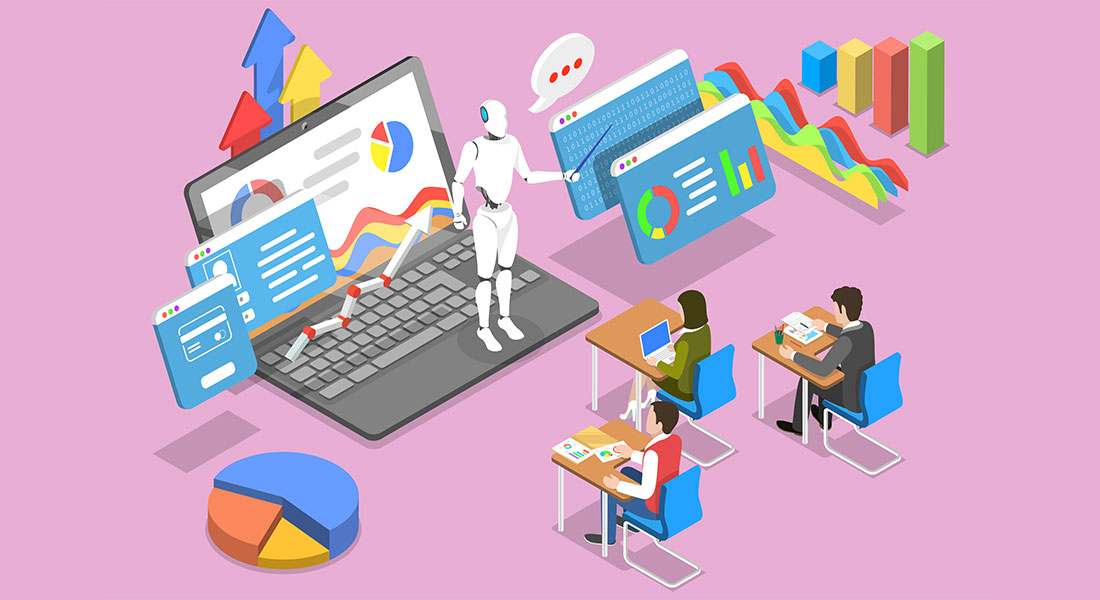AI in Training – What’s the Buzz About?
AI has made its place in every industry and eLearning too is not left untouched. From faster course development to providing critical training in a safe atmosphere, AI is already making a huge impact. Let’s discuss what all changes AI might bring to the eLearning scenario.

Artificial intelligence, or AI as we call it, refers to the intelligence of machines. But machines have been helping us for years, so why this buzz? It’s because these machines have never been as intelligent as they are today.
Yes, “intelligent machines” is not a far-fetched idea anymore. Now these machines are here as an integral part of our daily life. They can analyze data, perform repetitive tasks and solve complex issues, that too with speed and accuracy.
AI is Making a Significant Impact in the Corporate Learning Space.
Here are a few advantages of incorporating AI in the eLearning industry.
- Faster Course Development
- Personalized Learning
- Less Stress Inducing
- Provide Critical Training in a Safe Atmosphere
So, what does it mean for thelearning and developmentindustry? When applied to training, AI technologies can automate and enhance various aspects of the training process. In this article, we will discover where AI stands in the L&D sector and how to work with it to accelerate the training process and get better results.

Benefits of AI in Training
1. Faster Course Development
We know that going through lengthy information and analyzing huge amounts of data is second nature to AI. And that’s why it can work well with subjects requiring an enormous amount of information.
With its ability to understand the nitty-gritty of workflow and conceptualize it with the available data. AI becomes adept in creating basicdigital learningmodules with ease. Not to mention that it can do repetitive tasks with speed and efficiency. This helps AI in creating an intelligent tutoring system as a whole.
其能力的自动化的任务也可以帮助p in the translation ofeLearningcontent into multiple languages simultaneously. Something like this can remove any language barrier for the trainers and help them create sub-modules when required.
2. Personalized Learning
AI-powered algorithms can analyze a learner’s personal preferences. This includes understanding their strengths and exposing them to information related to their capabilities. This way, employees can be allocated tasks as per their strengths, leading to better on-the-job performance. In the same way, it can understand knowledge gaps and suggest corrective measures.
And in this connected world of today, it’s important to understand the cultural aspects of your diverse workforce. While it will be difficult for a human to study different cultures, AI can do it easily. And if needed, can add cultural references to convey messages clearly. This leads to faster learning and better knowledge retention.
→Get Access to a Live Action Course on Chat GPT in Instructional Design.
3. Less Stress Inducing
AI makes accessibility easy and less stressful at so many levels. At a fundamental level, AI software can help users in giving round-the-clock feedback. Which may not be possible in human interaction. Here as the point of contact for the participants is a machine, it can provide recruits with a space to make mistakes without the fear of judgment.
Apart from this, AI also solves a bigger purpose when it helps people with disabilities work from the comfort of their homes. This allows organizations retain good talent, which may not have been possible otherwise.
4. Provide Critical Training in Safe Atmosphere
Virtual Reality (VR) and Augmented Reality (AR) are the most useful elements when it comes to providingsimulationtraining. Here AI algorithms can be integrated into VR and AR training simulations to provide realistic experiences and give feedback to the participants regarding their response time. Such training is helpful for employees with crucial job roles where they face real dangers.
Here participants have the liberty to make mistakes while still in a safe environment. This gives the employees an on-the-job experience. And they can be sent to the field only when they are ready. Works well for people in the mining industry or those who need to operate heavy machinery.
Challenges of AI in Training
1. High Development Cost
One can’t deny the fact that modern equipment is needed to complement modern technology. And this is going to incur a lot of expense. Along with this, the integration of AI requires organizations to develop new skill sets among employees. And even if organizations are ready to roll out the capital, they will have to make efforts to create a work culture where employees won’t see AI as a threat.
Such requirements make AI limited to be used only by large organizations. That is the enterprises who understand the long-term benefits of such a technology.
2. Privacy Concerns
As AI collects and analyses large amounts of data, this may hinder an organization’s privacy.
We understand that AI has access to a large chunk of our data, not just at an organizational level but even at a personal level. Yes, we know that through advertisements that keep following us on social sites. In this case, organizations will have to be careful with the level of information they provide to these machines.
3. Susceptible to Biases
AI algorithms are only as unbiased as the data they are trained on. What if the person who provided the data was prejudiced? As a machine, AI will only take the information given to it. There’s no right or wrong for it. It works on commands and not thinking.
Insufficient or low-quality data is also something that can hinder AI’s problem-solving capabilities.
4. Machine Mishaps
AI is a machine and may go down here and there. Think about what will happen if your cell phone stops working at this moment?
Yes, any kind of technology is prone to hardware or software mishaps. This includes dealing with things like minor glitches to hackers trying to read into your system.

Wrapping Up
With so many issues around AI, what is the solution? Should we decide not to use it altogether? But this is not the solution, as even if you won’t use it, someone else surely will. The answer is to use it but with responsibility.
Some fundamental things which need to be in place before you start using it are as follows.
- Transparent policies and procedures to safeguard learner privacy and prevent unauthorized use of data.
- Upskilling programs for employees will help them work in harmony with the new technology. As it will help them become confident of not losing their jobs to AI.
- Regular auditing and monitoring of AI systems can help identify and rectify any biases that may creep in.
We know that AI has the potential to be an integral part of the L&D sector, but we need to remember that even if it’s intelligent, it’s still artificial.
The crux of the matter is we should stop seeing it as a dark cyborg who’s here to get us. But something which is here to assist us. Technology is not a threat if used wisely. At one point, even Microsoft Word was revolutionary and a perceived threat. But we know how easy it has made our work. And also created jobs which couldn’t have been thought of otherwise.
Technology has the potential to make life easy. The Advantages and disadvantages of anything depend upon how we use it. And at the end of the day, the one who gives commands to AI is a human. It’s a human who has the ultimate power to decide. And we always have a choice to make responsible decisions.
Interested to know more about AI in learning and development.Get access to our catalogue course on how to use Chat GPT in instructional design.






